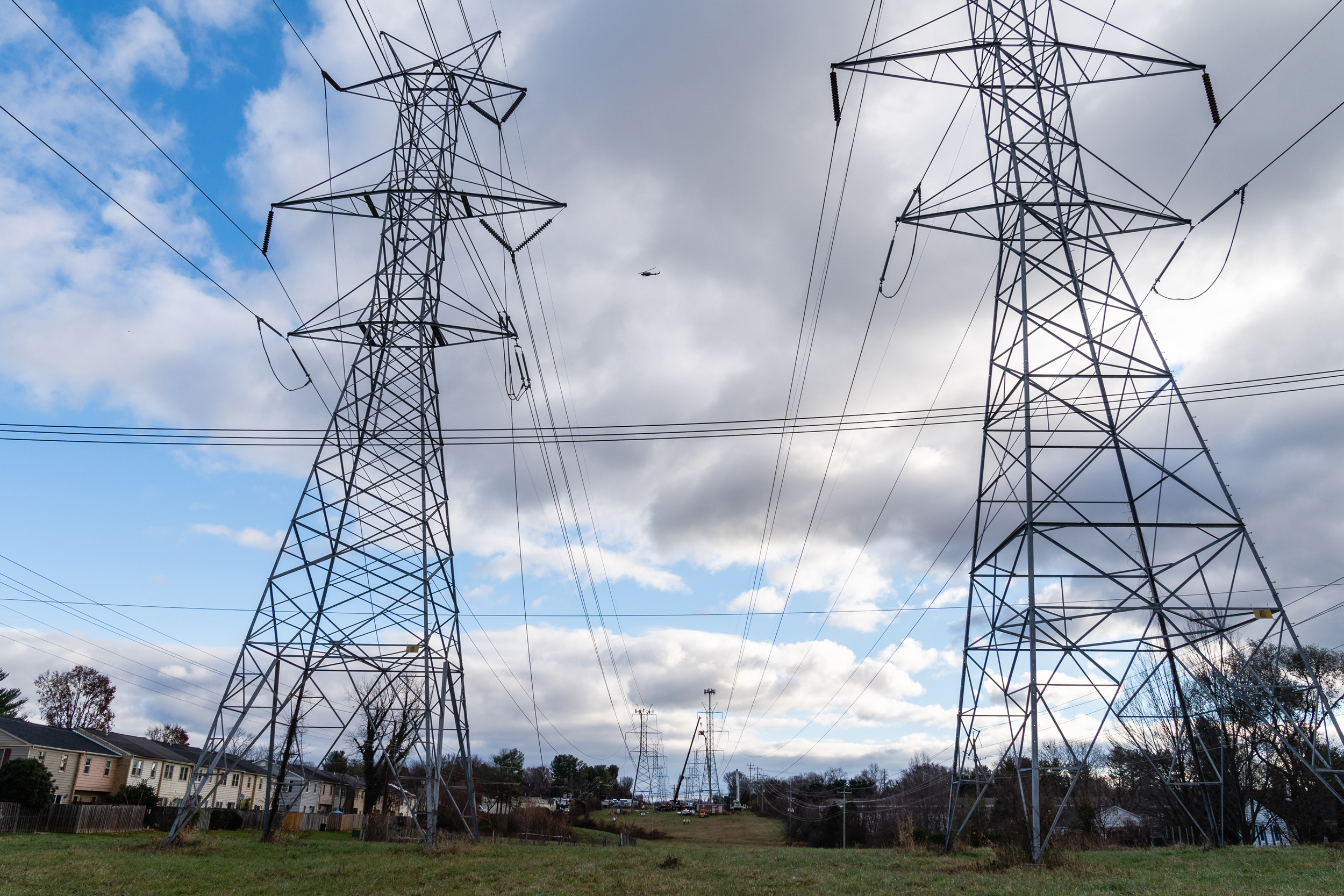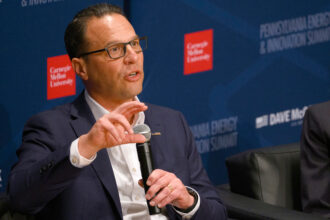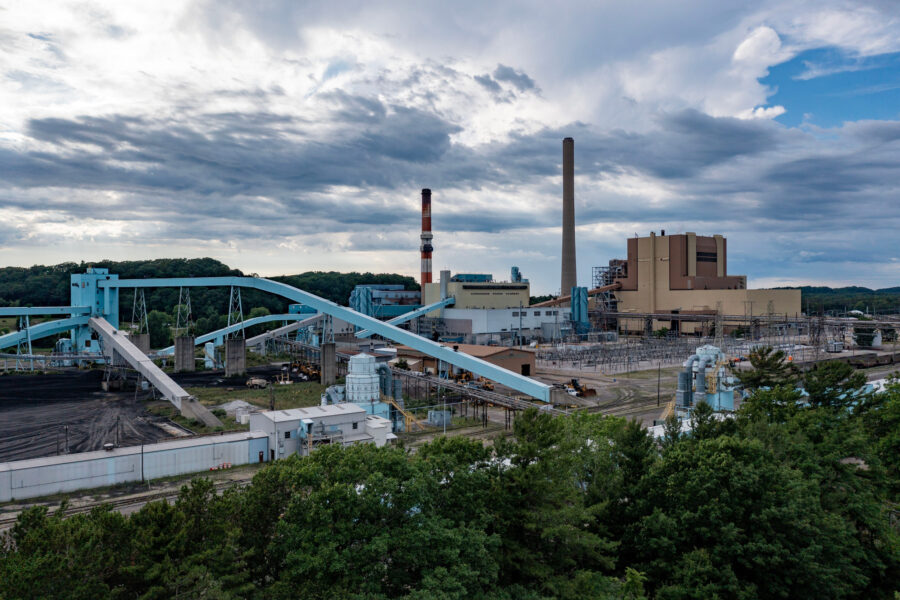Maryland lawmakers are leading a multistate, bipartisan effort to insulate ratepayers from the anticipated electricity price hikes as PJM Interconnection, the grid operator servicing 13 states and the District of Columbia, draws up proposals for investing hundreds of billions of dollars in grid upgrades, primarily to accommodate the load growth from new data centers.
The newly formed PJM State Legislators’ Collaborative, launched last week by Maryland Sen. Katie Fry Hester (D–Howard and Montgomery counties), brings together more than 60 lawmakers from across the PJM region, according to a statement from Hester’s office. The goal is to pressure the grid operator and federal regulators to prevent the costs associated with new data center-led demand from being passed on to households already burdened by rising electricity bills.
The initiative comes as PJM is finalizing a package of proposals for its board to vote on before submitting it to the Federal Energy Regulatory Commission (FERC). FERC’s decision will determine which plan moves forward and who bears the cost of 32 gigawatts of the expected new data center load.
The proposed changes will influence the June 2026 capacity auction and the 2028–2029 delivery year, experts say, and legislators are worried the capacity costs will likely shoot even higher as a result.
According to an estimate by the Natural Resources Defense Council (NRDC), without meaningful reforms, residents across the region could collectively pay an additional $163 billion in higher electricity bills through 2033. “By 2028, an average family in the region will be paying around $70 a month extra on their utility bills because of forecasted data center growth,” the NRDC report said. “Data centers should be required to bring their own power.”

“This decision will have far-reaching impacts beyond Maryland and the PJM region,” said Hester in a statement. “PJM’s filing with FERC, and FERC’s pending decision, will set a precedent for how the entire country manages the costs of massive new energy demands. State leaders must act now to avoid a massive transfer of wealth from residential ratepayers to large energy generators and data centers.”
A separate governors’ collaborative, formed last month, is also urging PJM to adopt reforms that protect consumers and small businesses from the anticipated surge in grid costs.
The PJM Market Monitor, an independent watchdog overseeing PJM’s wholesale power markets, said in its recent analysis that the extraordinary spikes in capacity market “are almost entirely the result of large load additions from data centers.”
“It is misleading to assert that the capacity market results are simply just a reflection of supply and demand. The current conditions are not the result of organic load growth,” the Monitor’s report said.
Hester told Inside Climate News she launched the legislative coalition as a rapid response to what she called a secretive, fast-tracked decision-making process within PJM.
“I tuned in to the stakeholder meeting and was floored by the speed, the complexity and the economic implications of what was being discussed,” she said. “PJM had switched from its first proposal, which would have protected ratepayers, to a second that totally bent a knee to Amazon, Google, Constellation and Exelon.”
She said she was alarmed by how little public representation there was in those discussions. “If the average person knew what was going on, they would go berserk,” she said.
But the tensions between lawmakers and PJM have flared, with the grid operator describing the collaborative’s argument as “not sound.”
“The discussions under the Critical Issue Fast Path process have nothing to do with customer-class cost allocation,” PJM spokesman Jeffrey Shields wrote in emailed comments. “That is in the hands of the states themselves through their retail rate-making regimes.”
The Critical Issue Fast Path (CIFP) is shorthand for PJM’s fast-tracked rule-making process meant to resolve urgent grid and market issues quickly with limited stakeholder input.
“Continued politicization of all things related to PJM will not solve the overall supply problem that states like Maryland are contending with,” Shields said. “This is a distraction that is not based in fact or an understanding of the fundamentals of utility regulation.” He said PJM would continue working with stakeholders—including states—to meet the challenge of accelerating demand growth driven by data centers and other large loads.
Hester rejected PJM’s claim that the CIFP process is unrelated to cost allocation, arguing that the process will directly shape capacity auction rules that determine how costs flow through to ratepayers.
“Retail ratemaking at the state level follows the PJM capacity auction,” she said. “When auction costs rise by billions of dollars, there is no choice but to collect those costs from ratepayers. Suggesting that we can ‘cost allocate’ our way out of billion-dollar increases is disingenuous.”
Pointing to PJM’s control over transmission planning, new generator connections and capacity markets, Hester said it is essential for PJM to “adopt a regional solution to both reliability and affordability that meets the needs of millions of ratepayers across the PJM region.”
Jon Gordon, senior policy director at the trade association Advanced Energy United, said PJM was technically correct that states retain authority over retail rate-setting, but that doesn’t mean PJM’s process doesn’t affect costs.
“There’s clearly a big piece of the ratepayer bill that originates from PJM,” he said. “Once PJM’s capacity auction prices are approved by FERC as ‘just and reasonable,’ the states get the bill … there’s no getting around that.” He explained that state regulators can decide how to spread those costs among customer classes over time, but “the size of the bill comes from PJM.”
This is why the collaboratives matter, Gordon said, explaining that legislators are fighting to influence that number before it reaches their public service commissions.
The new groups reflect a growing awareness among states that PJM’s decisions could leave them footing the bill for billions of dollars in grid upgrades, Gordon said. But he cautioned that while these alliances can exert pressure and improve customers’ understanding of cost allocation, their role remains largely advisory.
“These groups are doing more than just writing letters,” he said. “They’re on the stakeholder calls, arguing in real time for ratepayer protections … but the truth is, not all of this will be resolved in one fast-tracked process.” He described the legislators’ engagement as “a good and necessary shift,” noting that Hester and others have become “active voices on these highly technical calls that run for hours, hashing out solutions.”
Maryland’s electricity prices have surged in recent years, and PJM’s proposed upgrades, driven largely by the expected 32 gigawatts of new load demand from data centers, could push bills even higher.
“The default right now is that ratepayers are already paying,” said Maryland Del. Lorig Charkoudian (D-Montgomery County), saying that PJM was operating like a “shadow government” whose opaque markets “run roughshod” over state policy on affordability and climate. “Despite all of our best efforts and what we do at the state level, PJM, because of the nature of the markets, has the ability to override our policy. That’s why this collaborative is so important—to make it clear that we need PJM to act on this.”
This story is funded by readers like you.
Our nonprofit newsroom provides award-winning climate coverage free of charge and advertising. We rely on donations from readers like you to keep going. Please donate now to support our work.
Donate NowCharkoudian said the cost of inaction was already showing up on utility bills. “Ratepayers are already covering the projected increase in data centers through capacity auction prices that have gone up 900 percent and transmission projects being built as a result of that growth,” she said. “If a proposal is silent on who’s paying, then it is our residential ratepayers who are taking the brunt of it. This is a wealth transfer and subsidization of the largest corporations in the world.”
At the collaborative’s first meeting on Oct. 22, Delaware Sen. Stephanie Hansen said her state is now requiring large-load users, those that consume over 30 megawatts, to obtain certification that PJM can guarantee sufficient grid capacity. “PJM doesn’t want to be in the business of assuring that. But from the state’s perspective, who else can tell us whether there’s enough capacity?” she asked.
Illinois state Sen. Rachel Ventura said her state is confronting similar challenges. “We’re locking in costs for ratepayers, but we can’t let the largest users like data centers get out of paying, especially when we’re providing them incentives,” she said at the meeting. Ventura added that PJM’s 32-gigawatt projection may be inflated, pointing to evidence that data center developers are “shopping around and over-projecting their needs” to secure favorable terms.
As governments across the region debate how costs are split among different user classes, there is broad agreement that PJM’s lack of transparency is worsening the problem. “We’re making a $100 billion decision without the required analysis,” Hester said in the meeting, urging PJM to release detailed modeling on ratepayer impacts.
The initiative is also symptomatic of a paradoxical situation that states like Maryland are navigating: the eagerness to attract high-tech companies to invest in the state even as it struggles to keep a lid on the rising costs that come with them.
Gov. Wes Moore last year vetoed a bill calling for a multiyear study of the environmental impacts of data centers, arguing that the state couldn’t afford it. A year earlier, he had exempted data centers from a key Public Service Commission environmental review, seen as a signal to make Maryland more appealing to corporate developers seeking quick approvals and lower operating costs.
But states’ intent to attract data centers has slammed against a stubborn economic reality.
“They’re mad at PJM, not only for rates being so high but also for slamming the door on data center development,” said Gordon from Advanced Energy United. “You can’t have it both ways.”
He added that most data-center developers have now accepted they’ll need to “bring their own generation,” calling it a costly and time-consuming proposition that could reshape the region’s energy landscape. “At the end of the day, data centers are going to have to pay for most of this,” he said. “Their biggest issue isn’t the money—it’s speed.”
Charkoudian said that part of the problem stems from PJM’s years-long backlog of clean-energy projects awaiting interconnection. “States have been trying to build new generation for years, but PJM’s bureaucracy has held it up,” she said. “We would still have to deal with this massive load growth, but the urgency would be far lower if PJM hadn’t had such a dysfunctional queue for so long.”
Hester said the legislators’ group will meet weekly to coordinate responses ahead of PJM’s November board vote and the grid operator’s expected filing with the FERC. “The market is not working,” she said. “We’re trying to remind PJM that its fiduciary responsibility is to ratepayers —not to line the pockets of Amazon, Google, and Microsoft.”
Following the late November vote, PJM will send the final package of proposals to FERC, which will determine which plan moves forward.
About This Story
Perhaps you noticed: This story, like all the news we publish, is free to read. That’s because Inside Climate News is a 501c3 nonprofit organization. We do not charge a subscription fee, lock our news behind a paywall, or clutter our website with ads. We make our news on climate and the environment freely available to you and anyone who wants it.
That’s not all. We also share our news for free with scores of other media organizations around the country. Many of them can’t afford to do environmental journalism of their own. We’ve built bureaus from coast to coast to report local stories, collaborate with local newsrooms and co-publish articles so that this vital work is shared as widely as possible.
Two of us launched ICN in 2007. Six years later we earned a Pulitzer Prize for National Reporting, and now we run the oldest and largest dedicated climate newsroom in the nation. We tell the story in all its complexity. We hold polluters accountable. We expose environmental injustice. We debunk misinformation. We scrutinize solutions and inspire action.
Donations from readers like you fund every aspect of what we do. If you don’t already, will you support our ongoing work, our reporting on the biggest crisis facing our planet, and help us reach even more readers in more places?
Please take a moment to make a tax-deductible donation. Every one of them makes a difference.
Thank you,













